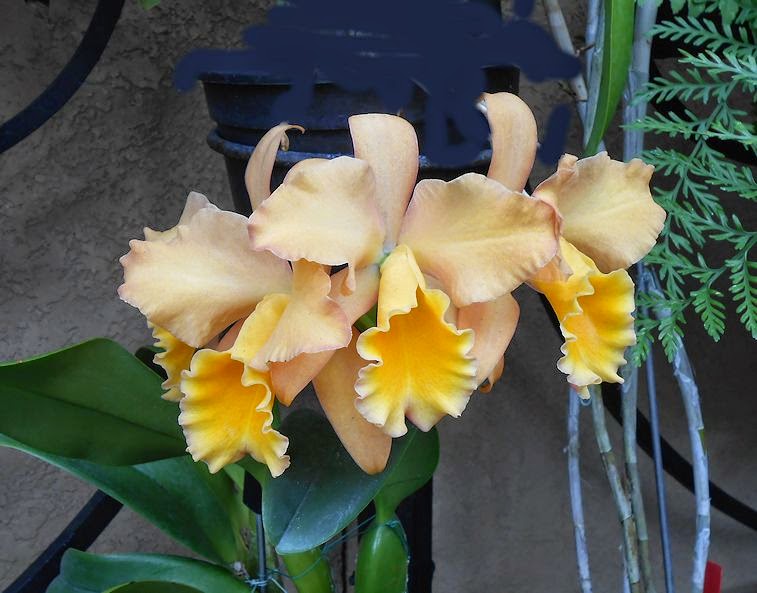One greenhouse is devoted only to orchids, and hundreds of blooming varieties cover
the walls. In addition, there are five working greenhouses where the orchids develop and
grow. Only when they are in full bloom are they put on display. There is usually a member
of the local orchid society on hand to talk about the orchids or answer questions.
There are more than 26,000 species of orchids, more than four times the total number of
mammal species on earth. They make up more than 10% of all seed plants on earth.
This is "Buttercup," a Cattleya Orchid.
More than 100,000 hybrid varieties of orchids have been developed thus far.
"Winged Flight" is yellow and purple.
"Pretty Petticoat." White Cattleya Orchids.
One corner of the Orchid Room, leading into the African Flowers display.
Longwood has 7,5000 orchids from 2,000 species, and they are slowly growing
their collection larger.
"Astrid." Horned Dendrobium
"Feather Soft." Dendrobium Orchid.
"Chili Peppers." Dendrobiums
'Fluttering." Orchids
Another corner and niche in the Orchid Room. They are sometimes arranged by species
and sometimes by color. The niche to the right usually shows lavender and purple orchids,
while the next niche to the right usually shows only white orchids.
"Hot Pink Passion." Orchids
"Princess Royal." Cattleya Orchids. These were the most popular cut flowers
of all the orchids until the 1980s, when corsages dropped out of fashion.
These days, whole orchid plants are more popular.
"Artemis." Cattleya Orchids
"Sir Humphrey" Warner Cattleya Orchids. Many orchids are named
after the person who first saw them or hybridized them, or in memory of his mother.
"Fredericke" Angulocaste Orchids. I liked these rather large, magnolia like flowers,
on long tendrils. They also had them in pure white and cream. They are rather large,
One of my favorites is this Rhynchostylis Orchid, the national flower of Honduras.
All the members of this family come in shades of green, from very pale and almost white to
a medium pea green,. And all have the frilly edges to the throat.
"Mlle Nitouche" white orchids
"Hannah's Dream" White Phalaenopsis
"Bea Swarm." Some orchids are very small individually, but come in large clusters
or sprays, like this copper and pale yellow variety.
"Lady Diana's Nightgown"
"Wingspan" White Cattleya Orchids
"Gammer Gurton's Apron" Orchids
"A Touch of Butterscotch" Cattleya Orchids
"Crème de la Crème" White Cattleya Orchids
"Flossie's Fancy" Cattleya Orchids from Costa Rica
"Jennifer's Delight" Pink Orchids
"Out of Africa" Spotted Orchids
"South of Aswan" Orchids
"Tawney Flashes" Orchids
"Starburst" Cattleya Orchids
"Everest Snows" White Cattleyas.
___
One large public greenhouse is given to Hibiscus, which are grown in many colors.
From these "mother plants," they take cuttings to grow more plants for other buildings
and gardens. In general, Longwood does not develop hybrids, but buys them from
individual horticulturalists and shows them to the public.
"Swiss Hibiscus" with white and red pattern, like the Swiss flag.
"Smoky Mountain Hibiscus", soft pink and grey mist
"Peach Froth," a lovely double hibiscus with two rings of petals instead of just one
"Brilliant Red," a new variety
"Felicity" is a lovely variety in pale yellow with white center
"Red Explosion" with white radiating rays
"Early Morning," buttery yellow with red center
"Maud Tuttle," named for a benefactor
This is the Chalice Vine which climbs all the way to the ceiling of the greenhouse
and produces flowers 10" across which look like a large goblet or chalice. These plants
grow above the hibiscus and are very aggressive and fast growing.
grow above the hibiscus and are very aggressive and fast growing.
__
__








































































